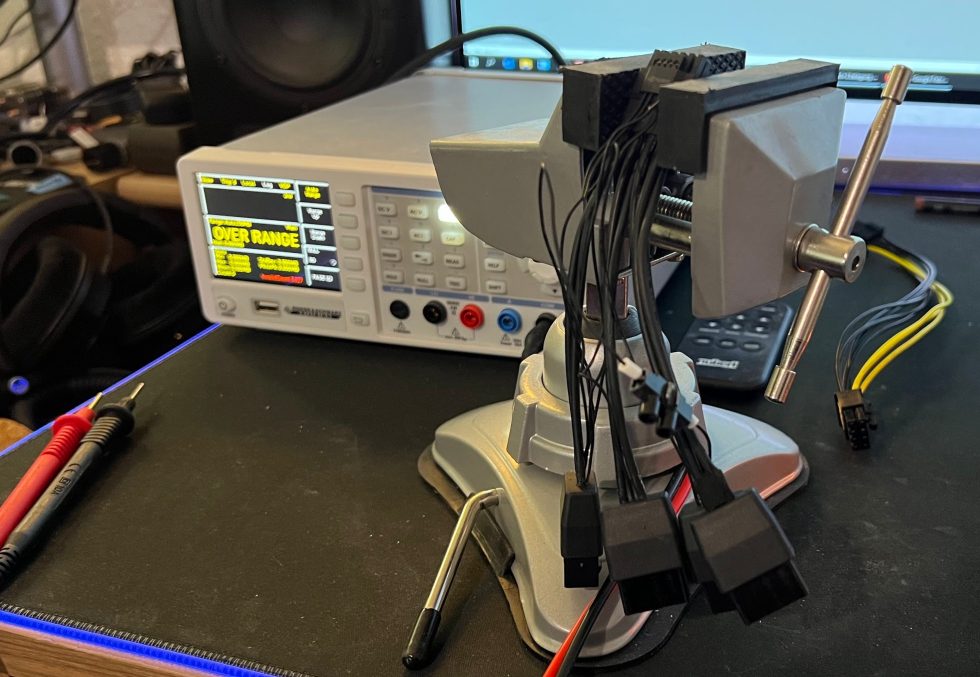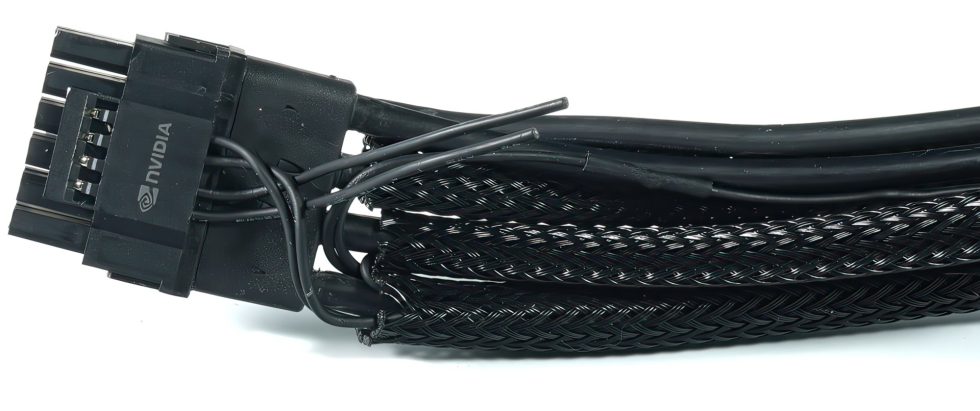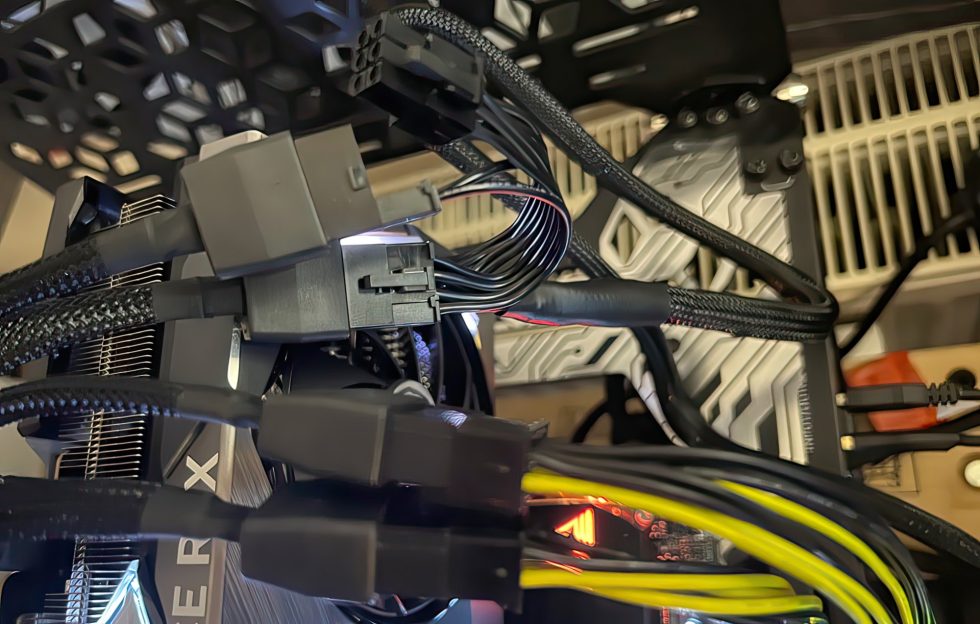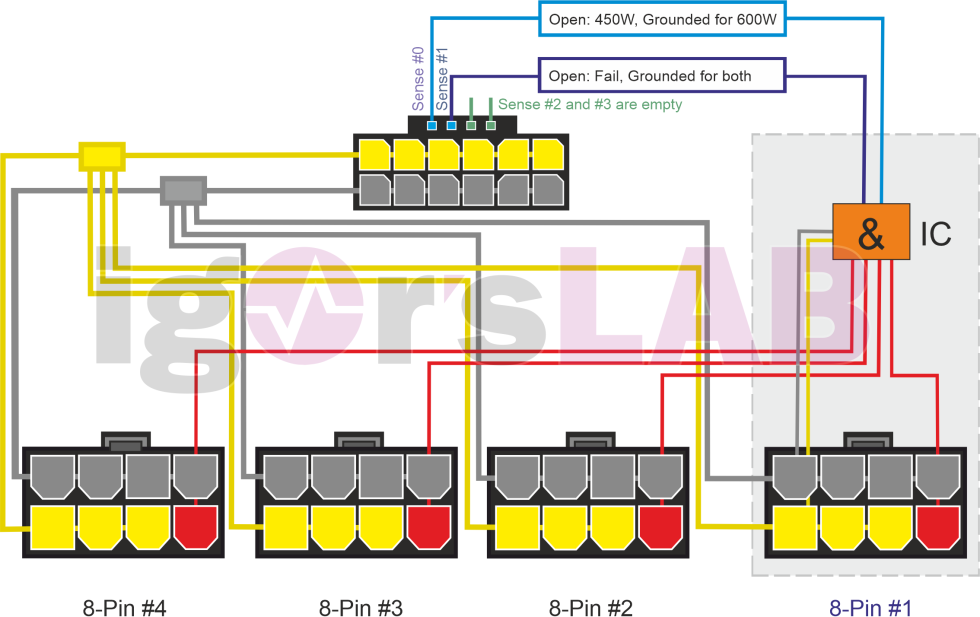Who doesn’t know it, the funny adapter from NVIDIA, with which you can merge four PCIe 6+2 pin cables to be able to run graphics cards with up to 600 watts? If you only connect three plugs, you’ll only get 450 watts and with two plugs, the PC won’t start at all with a bit of bad luck. It also doesn’t matter which of the four ports you leave free. However, it was exactly this circumstance that aroused my curiosity, because there were definitely problems in the interaction of the “smart” adapter and the firmware of some on-board partner cards that should not have occurred like this.

The trick with the smart adapter
Of course, one could have simply unraveled (and thus certainly destroyed) all of this, but first, I don’t have that many adapters, and second, it’s always a sporting challenge to get such details out that way, too. I had said in the launch video that the card could theoretically be operated with a single 6+2-pin cable and was then severely criticized by some. It is in the nature of things that it works, but you also have to know how this adapter works. Since NVIDIA did not even want to reveal how the adapter’s logic works to board partners and power supply manufacturers, only their own lab remained.
A small preliminary remark is also important: For all pinouts I consider the 12VHPWR as male and the four 8-pin connectors as female, so that the pinouts are mostly mirror-inverted to what you usually find on the internet for the respective connectors. Everything described here in the following concerns the respective front view of the adapter’s connections and not the graphics card or plugged 6+2 pin cables!

Even before the launch, I had noticed that the power limit of the RTX 4090 FE automatically decreases when you leave out a cable. This is annoying in that NVIDIA’s nice PCAT tool for measuring power consumption only has three rails. But since I have a very well-stocked cable box, a Y-piece was quickly found. That then also went quite well. Out of a certain curiosity, I then staked out the fourth port and experienced a disaster with a board partner card. But I’ll get to that in a moment, when it comes to the partly inexplicable effects and various BIOS errors. If you plug in only the 2-pin (sense) instead of the whole 6+2 connector and leave out the 6-pin for 12V and ground, then everything works as desired. Do you notice anything?

But that would be much too easy and NVIDIA always counts on the “cluelessness” of the customers. So it had to be a simple switching logic (some AND gates) which then switches the two pins of the 12VHPWR accordingly. So I uncovered all the cables and actually saw exactly what I had expected from my first measurements between the cables. Without connected cables, the six 12V pins and the six ground pins are already bridged in this plug, so that there is only one voltage rail. Of course, this also eliminates the possibility of detecting missing rails, as you used to be able to do circuit-wise on the graphics card board when a connector was missing. And that’s exactly why the whole story can unfortunately be operated with a single cable, if you additionally do some tricks.
One of the two sense pins per 6+2 socket was not directly connected to any of the lines, not even to the first two sideband contacts that are responsible for detecting the TBP in the 12VHPWR. However, the resistance was also not infinitely large, but was in the range of usual IC inputs. Aha, there we have it!

But let’s take another quick look at my exposed tangle of cables: What do we see in detail now? On the one hand, only one 12-volt and ground wire per socket leads to the 12VHPWR, which is not a big deal due to the shortness of the cable. And metrologically, the upper of the two sense pins is still connected directly to ground in the socket. And then it gets interesting! There are 5 wires leading to the first 8-pin socket: the two from the sense pins of the 12VHPWR connector and three additional wires, one of which leads to each of the other connectors.
Of course, this also means that a small switching logic must be installed in the first socket, which is also supplied via the 12V line. Since we already know that on the 12VHPWR all the lines are bridged on a single rail, so cable #1 doesn’t even need to be connected to the power supply if at least one other has been connected. Once you have found this out, you can draw a block diagram for clarity, which illustrates the whole thing nicely:
If only two cables or less are connected, sense pin #1 is not connected to ground and the card already refuses to work during the boot process. With three cables or four, sense #1 is connected to ground and only with all four cables connected, sense #0 is also connected to ground. Only if both pins are connected to ground, the full 600 watts are available.
This would also clarify how NVIDIA’s smart “miracle adapter” works. Stupidly, if you are an Alibaba protagonist, you can simply omit the IC and integrate a small fixed jumper that simply connect the both first sense pins on the 12VHPWR to ground. Therefore my warning: please do NOT buy something like this! However, what happens when the BIOS still has a hard time with the new, graduated TBP world, you can read on the next page. And it also explains why there were colleagues who had problems with the delivered board partner card even before the launch.

































97 Antworten
Kommentar
Lade neue Kommentare
Urgestein
Urgestein
Urgestein
1
Veteran
Urgestein
Urgestein
Urgestein
1
Urgestein
Urgestein
Urgestein
1
1
Alle Kommentare lesen unter igor´sLAB Community →